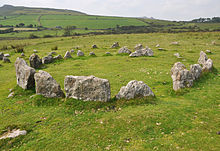Yellowmead Down
The concentric stone circle of Yellowmead Down is an extraordinary multiple stone arrangement on the western edge of a small plateau in Dartmoor National Park between the hamlets of Sheepstor and "Ditsworthy Warren" in Devon , England . The largest of the four ovals is around 20 m in diameter and the small inner ring is 6.7 m in diameter. Stone circles of this type are usually from the Bronze Age .
investment
The arrangement, to which a closely spaced row of stones belongs, consists of four nested stone circles , but the three outer ones have an oval shape and are not actually arranged concentrically to either the inner circle or to each other, as is often the case with concentric circles.
The center is a barely noticeable cairn of about four meters in diameter, which is centrally surrounded by the rectangular plates of the inner circle. The inner ring with a diameter of 6.7 m is the only one that is round and consists of 22 stones almost one meter high. The second ring consists of 32 stones, usually less than 0.25 m high, which form a weak oval of around 11 m × 12 m. The third ring is also formed from low stones, with several of its 27 remaining stones in the southern area of the oval of around 14-15 m. The outer oval of 24 stones has a diameter of 19-20 m. It has larger gaps in the northeast, where stones have apparently been removed for a clapper bridge . It contains the largest stones from Yellowmead Down, measuring just over a meter in the southeast. One of them has at least two bowls . In the west of the rings are stones that form an imprecise arc. They could belong to a largely destroyed fifth ring.
Towards the southwestern edge of the Yellowmead Down plateau lies a small cluster of low stones that form the remains of a row of stones or an avenue.
exploration
The complex was excavated and restored in 1921 by the Reverend Hugh Breton (1873-1936). This was checked geophysically in 2008. In order to determine whether the 1921 restoration was accurate enough, probes were carried out and more stones were found.
literature
- Aubrey Burl (text), Max Milligan (photographer): Circles of Stone. The prehistoric rings of Britain and Ireland . The Harvill Press, London 1999, ISBN 1-86046-661-3 .
- Aubrey Burl: The Stone Circles of Britain, Ireland, and Brittany. Yale University Press, New Haven 2000, ISBN 978-0-300-08347-7 .
Individual evidence
- ↑ Aubrey Burl is of the opinion that the second and third oval were originally formed from 42 stones.
- ↑ A. Burl estimates that there were about 37 stones in this ring.
Web links
- Description and map , accessed on May 28, 2011.
- Image viewed May 10, 2012.
- Description Engl. Site plan and pictures
Coordinates: 50 ° 29 ′ 34.7 " N , 4 ° 0 ′ 38" W.

